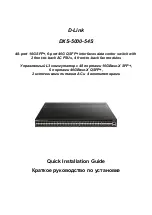
•
Click
Submit
to apply the new configuration and cause the change to take effect immediately. These
changes will not be retained across a power cycle unless a Save is performed.
•
Click
Cancel
to cancel and redisplay the hostname IP mapping page to see the configured
hostname-IP mapping entries.
DNS Source Interface Configuration
Use this page to specify the physical or logical interface to use as the DNS client source interface. When
an IP address is configured on the source interface, this address is used for all DNS communications
between the local DNS client and the remote DNS server. The IP address of the designated source
interface is used in the IP header of DNS management protocol packets. This allows security devices,
such as firewalls, to identify all source packets coming from a specific device.
To access the DNS Source Interface Configuration page, click
System
>
Advanced Configuration
>
DNS
>
Source Interface Configuration
in the menu.
Table 60: DNS Source Interface Configuration Fields
Field
Description
Type
The type of interface to use as the source interface:
•
None – The primary IP address of the originating (outbound) interface is used as
the source address.
•
Interface – The primary IP address of a physical port is used as the source
address.
•
Loopback – The primary IP address of the loopback interface is used as the
source address. A loopback is always reachable, as long as any routing interface is
up.
•
VLAN – The primary IP address of a VLAN routing interface is used as the source
address.
Interface
When the selected Type is Interface, select the physical port to use as the source
interface.
Loopback Interface
When the selected Type is Loopback, select the loopback interface to use as the
source interface.
VLAN ID
When the selected Type is VLAN, select the VLAN to use as the source interface. The
menu contains only the VLAN IDs for VLAN routing interfaces.
Tunnel ID
When the selected Type is Tunnel, select the tunnel interface to use as the source
interface.
If you change any of the parameters, click
Submit
to apply the changes to the system. If you want the
switch to retain the new values across a power cycle, you must save the configuration.
Configuring Email Alerts
With the email alerting feature, log messages can be sent to one or more email addresses. You must
configure information about the network
SMTP (Simple Mail Transfer Protocol)
server for email to be
successfully sent from the switch.
Configuring System Information
ExtremeSwitching 200 Series: Administration Guide
83
















































